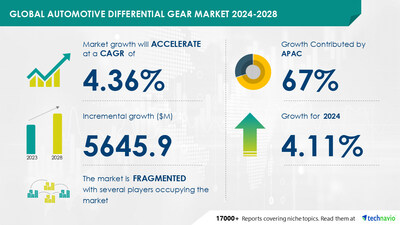NEW YORK, July 26, 2024 /PRNewswire/ — The global automotive differential gear market size is estimated to grow by USD 5.64 billion from 2024-2028, according to Technavio. The market is estimated to grow at a CAGR of 4.36% during the forecast period. increase in sales of SUVs is driving market growth, with a trend towards development of hub motors. However, product recall poses a challenge. Key market players include American Axle and Manufacturing Holdings Inc., AmTech International, Bharat Gears Ltd., Circle Gear and Machine Company Inc., Dana Inc., Eaton Corp. Plc, FA.TA. Ricambi S.p.A., Gear Motions Inc., GKN Sinter Metals Engineering GmbH, Hitachi Ltd., Linamar Corp., Neapco Holdings LLC, NSK Ltd., Perfect Gears Pvt. Ltd., Polaris Inc., and Shandong Heavy Industry Group Co. Ltd..
Get a detailed analysis on regions, market segments, customer landscape, and companies- View the snapshot of this report
|
Automotive Differential Gear Market Scope |
|
|
Report Coverage |
Details |
|
Base year |
2023 |
|
Historic period |
2018 – 2022 |
|
Forecast period |
2024-2028 |
|
Growth momentum & CAGR |
Accelerate at a CAGR of 4.36% |
|
Market growth 2024-2028 |
USD 5645.9 million |
|
Market structure |
Fragmented |
|
YoY growth 2022-2023 (%) |
4.11 |
|
Regional analysis |
APAC, North America, Europe, South America, and Middle East and Africa |
|
Performing market contribution |
APAC at 67% |
|
Key countries |
US, China, Japan, India, and Germany |
|
Key companies profiled |
American Axle and Manufacturing Holdings Inc., AmTech International, Bharat Gears Ltd., Circle Gear and Machine Company Inc., Dana Inc., Eaton Corp. Plc, FA.TA. Ricambi S.p.A., Gear Motions Inc., GKN Sinter Metals Engineering GmbH, Hitachi Ltd., Linamar Corp., Neapco Holdings LLC, NSK Ltd., Perfect Gears Pvt. Ltd., Polaris Inc., and Shandong Heavy Industry Group Co. Ltd. |
Market Driver
The global automotive differential gear market is experiencing significant growth due to the increasing demand for electric vehicles (EVs). With stricter emission norms, the ban on diesel-powered vehicles, EV subsidies, and expanding charging infrastructure, the sales of EVs are tripling worldwide. In response, manufacturers are focusing on developing advanced solutions to enhance EV range and performance. One such solution is the wheel hub motor, an electric motor directly installed in the vehicle wheel to power it. Hub motors use brushless direct current (BLDC) technology, an advanced version of DC motors, which improves power density and eliminates the need for contact between the stator and rotor, increasing motor life. Hub motors directly drive the vehicle wheel, eliminating the need for a gearbox, differential, and other power transmission components, reducing vehicle weight and improving efficiency. However, challenges such as decreased vehicle speed, increased unsprung weight, and complex harness design are hindering hub motor adoption. Despite these challenges, companies like Protean Electric, GM, Elaphe Propulsion Technologies Ltd., Brabus GmbH, ZIEHL-ABEGG SE, and Dana TM4 are investing in hub motor technology, which is expected to lead to technologically advanced hub motors and positively impact the global automotive differential gear market.
The Automotive Differential Gear Market is witnessing significant growth due to increasing demand for automotive vehicles, especially in the segments of Premium SUVs, Sedans, Heavy Duty Engine vehicles, Heavy Commercial Vehicles, Light Commercial Vehicles, Heavy Trucks, and Electric Vehicles. Key trends include the use of traction motors, electric motors, and electric compressors in Electric Vehicles. Batteries, power electronics, and gearboxes are also in high demand. The focus is on improving engine power and vehicle performance, while reducing weight, size, and noise. Gearboxes are essential for Passenger Cars, Trucks, and Buses to manage speed and torque during turns and braking. Locking Differential and Torque Vectoring Differential technologies enhance traction control and response time. Front Wheel Drive and Rear Wheel Drive systems use epicyclic trains, rotation shafts, and rear axles for efficient power transfer. The market is expected to grow as automotive manufacturers continue to innovate and improve the design and functionality of differentials for various vehicle types.
Discover 360° analysis of this market. For complete information, schedule your consultation – Book Here!
Market Challenges
- The automotive differential gear market is witnessing significant advancements with the integration of automatic transmission systems in premium vehicles. These systems utilize complex algorithms, multiple clutches, and synchromesh gear sets, along with lightweight and rigid materials, enhancing drivability. However, these developments increase the cost and complexity of the drivetrain. Any malfunction or issue in a single component, such as differential gears, can lead to high repair costs and vehicle recalls, impacting both the component maker and the OEM due to liability-sharing business models. In recent times, recalls by Benz U.S. (May 2022) and Volkswagen AG (March 2022) highlight the vulnerability of drivetrains. These recalls, due to corroded brake boosters and differential gear leakage, respectively, result in increased costs for all stakeholders and limit market growth during the forecast period.
- The Automotive Differential Gear Market faces challenges in various vehicle segments, including trucks, buses, and commercial vehicles. Traction is crucial in off-road applications and locking differentials provide the solution. However, torque vectoring differentials offer improved handling and response time for passenger vehicles. Size and weight reduction are essential for multi-utility and autonomous vehicles. Front-wheel and rear-wheel drive systems require efficient differentials for optimal performance. The epicyclic train, gears, shafts, and rear axle are key components. High-speed curves and braking systems demand efficient differentials with quick response time and control. Weight and size reduction are essential for compact vehicles, making lighter, quieter, and efficient differentials a priority. Electrification in automotive vehicles necessitates advanced electronic control units to manage torque distribution and traction control. Slippage must be minimized to ensure efficient power transfer. Handling and performance are critical factors, especially in high-performance vehicles. Electronic circuits and traction control systems are becoming increasingly important to maintain optimal drive wheel torque during turns. The market must address these challenges to cater to the diverse needs of the automotive industry.
For more insights on driver and challenges – Request a sample report!
Segment Overview
This automotive differential gear market report extensively covers market segmentation by
- Channel
- 1.1 Aftermarket
- 1.2 OEM
- Vehicle Type
- 2.1 Passenger cars
- 2.2 Commercial vehicles
- Geography
- 3.1 APAC
- 3.2 North America
- 3.3 Europe
- 3.4 South America
- 3.5 Middle East and Africa
1.1 Aftermarket- The automotive aftermarket serves as a significant sector in the global automotive industry, encompassing the production, supply, and installation of various vehicle components post-original equipment manufacturer (OEM) sale. This segment includes replacement parts for wear and tear, collision repairs, aesthetic enhancements, and performance upgrades. The aftermarket caters to a vast array of parts for diverse vehicle makes and models, offering consumers flexibility in choosing repair shops or handling DIY repairs. This freedom of choice, coupled with the availability of parts of varying quality and affordability, ensures that vehicles remain operational and customizable. These aspects propel the expansion of the global automotive differential gear market throughout the forecast period.
For more information on market segmentation with geographical analysis including forecast (2024-2028) and historic data (2017-2021) – Download a Sample Report
Learn and explore more about Technavio’s in-depth research reports
The global Automotive Constant Velocity Joint (CVJ) market is experiencing steady growth, driven by increasing demand for high-performance vehicles and advancements in automotive technology. Similarly, the global Automotive Direct Drive Motor market is expanding rapidly, fueled by the shift towards electric vehicles (EVs) and the need for more efficient propulsion systems. The global Metal Stamping market is also on the rise, bolstered by its applications in the automotive, aerospace, and electronics sectors. Key trends include technological innovations, regulatory changes, and growing end-user demand.
Research Analysis
The Automotive Differential Gear Market encompasses various types of vehicles, including Premium SUVs, Sedans, and commercial vehicles such as Heavy duty engines for Heavy Commercial Vehicles and Light Commercial Vehicles, Heavy Trucks, and Buses. Differentials are essential components in these vehicles, enabling power transmission to the wheels while accommodating the difference in wheel speed during turns. Electric vehicles integrate Differentials with Traction Motors, Electric Motors, and Electric Compressors, while Batteries and Power Electronics play a crucial role in their functioning. Gearboxes, with their epicyclic trains, rotation shafts, and rear axles, facilitate the required speed gears for optimal vehicle performance. Differentials come in various configurations like Locking Differential, Torque Vectoring Differential, and Front Wheel Drive (FWD) or Rear Wheel Drive (RWD) systems. The engine power and vehicle type determine the specific differential requirements, with Passenger Cars and Trucks having unique needs. In summary, the Automotive Differential Gear Market caters to a diverse range of vehicles, ensuring efficient power transmission and optimal vehicle performance through various differential configurations and components.
Market Research Overview
The Automotive Differential Gear Market encompasses various types of vehicles, including Premium SUVs, Sedans, Heavy duty engines, Heavy commercial vehicles, Light commercial vehicles, Heavy trucks, Electric vehicles, and Buses. Differentials are essential components in these vehicles, enabling power transmission to the drive wheels while accommodating the difference in wheel speed during turns. Differentials come in various configurations such as Traction motors, Electric motors, and Electric compressors in Electric vehicles. They are integrated with Batteries, Power electronics, and an Electronic Control Unit for optimal performance. Differentials are used in Passenger cars, Trucks, and Multi Utility Vehicles, catering to diverse applications like Off-road vehicles and Autonomous vehicles. The market focuses on developing compact, lighter, quieter, and efficient differentials for improved vehicle performance. Differentials are designed to handle high engine power and provide optimal response time during curve negotiation, ensuring effective traction control and handling. They are available in various configurations, including Front Wheel Drive, Rear Wheel Drive, and Torque Vectoring Differential systems. The market also caters to the needs of Heavy trucks and Buses, offering differentials suitable for high weight and size reduction applications. The latest trends include the integration of electronic circuits for enhanced control and improved braking system response time. In summary, the Automotive Differential Gear Market is a dynamic and evolving industry that focuses on developing advanced, efficient, and compact differentials for various vehicle applications, including passenger cars, trucks, and electric vehicles. These differentials cater to diverse requirements, such as high engine power, optimal response time, and effective traction control, ensuring improved vehicle performance and handling.
Table of Contents:
1 Executive Summary
2 Market Landscape
3 Market Sizing
4 Historic Market Size
5 Five Forces Analysis
6 Market Segmentation
- Channel
- Aftermarket
- OEM
- Vehicle Type
- Passenger Cars
- Commercial Vehicles
- Geography
- APAC
- North America
- Europe
- South America
- Middle East And Africa
7 Customer Landscape
8 Geographic Landscape
9 Drivers, Challenges, and Trends
10 Company Landscape
11 Company Analysis
12 Appendix
About Technavio
Technavio is a leading global technology research and advisory company. Their research and analysis focuses on emerging market trends and provides actionable insights to help businesses identify market opportunities and develop effective strategies to optimize their market positions.
With over 500 specialized analysts, Technavio’s report library consists of more than 17,000 reports and counting, covering 800 technologies, spanning across 50 countries. Their client base consists of enterprises of all sizes, including more than 100 Fortune 500 companies. This growing client base relies on Technavio’s comprehensive coverage, extensive research, and actionable market insights to identify opportunities in existing and potential markets and assess their competitive positions within changing market scenarios.
Contacts
Technavio Research
Jesse Maida
Media & Marketing Executive
US: +1 844 364 1100
UK: +44 203 893 3200
Email: [email protected]
Website: www.technavio.com/
![]() View original content to download multimedia:https://www.prnewswire.com/news-releases/automotive-differential-gear-market-size-is-set-to-grow-by-usd-5-64-billion-from-2024-2028–increase-in-sales-of-suvs-boost-the-market-technavio-302206674.html
View original content to download multimedia:https://www.prnewswire.com/news-releases/automotive-differential-gear-market-size-is-set-to-grow-by-usd-5-64-billion-from-2024-2028–increase-in-sales-of-suvs-boost-the-market-technavio-302206674.html
SOURCE Technavio

Featured image: I Stock © pcess609






